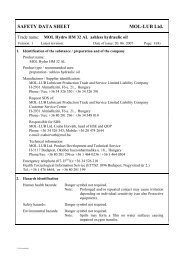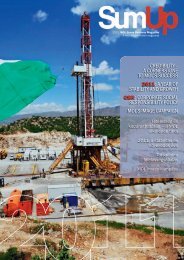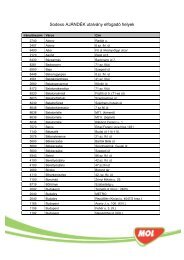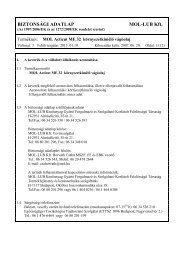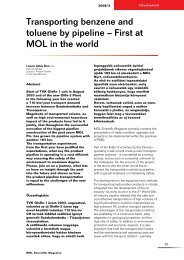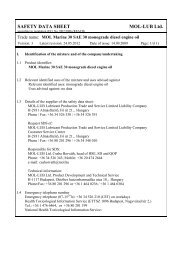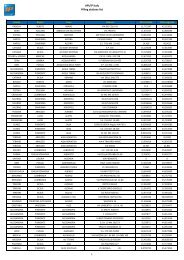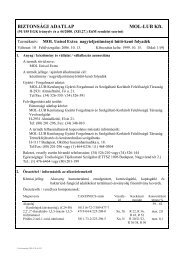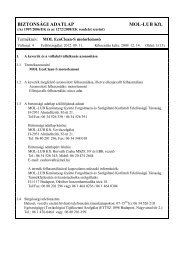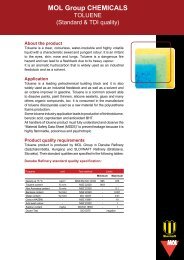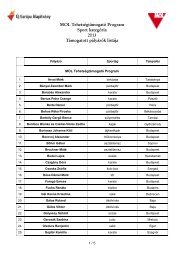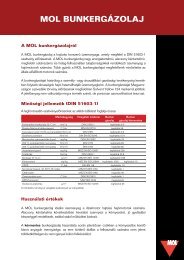Logistic brochure (pdf, 3.3 MB) - Mol
Logistic brochure (pdf, 3.3 MB) - Mol
Logistic brochure (pdf, 3.3 MB) - Mol
You also want an ePaper? Increase the reach of your titles
YUMPU automatically turns print PDFs into web optimized ePapers that Google loves.
To our readers<br />
Through this publication, we should like to acquaint you with the activities of the MOL Group <strong>Logistic</strong>s<br />
Unit, its equipment and its operations. We would also like to review the market demands the current<br />
system was established to meet, along with important developments it has had to respond to.<br />
The key competitive factors in the area of <strong>Logistic</strong>s are focus on the customer, cost-effectiveness<br />
and optimal execution of distribution and storage functions. One of the organisation’s top priorities is to<br />
maintain the quality of refinery products throughout the logistics process, up to and including the<br />
customer storage tank, or the customer vehicle fuel tank at our filling stations.<br />
One of the decisive results of change over the last decade has been that competition in the oil industry<br />
has now focused on the supply chains of integrated oil companies, rather than on products, salesmen,<br />
or refineries. Fast response to market change, focus on the customer and optimal orchestration of the<br />
crude oil supply-refining-distribution-marketing sequence, have become crucial competitive factors.<br />
The MOL Group <strong>Logistic</strong>s Unit – similar to other organisations – is characterised by the constant need<br />
to improve. As a result of comprehensive technical upgrades during the early 90’s, our storage depots<br />
are now fully in compliance with stringent EU environmental specifications, in every respect. In addition,<br />
the modernisation and automation of our loading systems and tanker lorry fleet have also been carried<br />
out. The successful functioning of our logistics processes is supported by a state-of-the-art information<br />
system, which on one hand delivers more accurate planning and execution of such processes, and on the<br />
other, has increased the security of our assets.<br />
From 2001 onwards, this approach was gradually and successfully introduced along the entire MOL<br />
Refining & Marketing Division (RMD) supply chain, together with associated execution of decision-making<br />
and implementation tasks. The MOL <strong>Logistic</strong>s Unit now operates as an integral part of that supply<br />
chain. Its valuable contribution can be gauged principally by the healthy state of RMD profitability today.<br />
As MOL Group operations expanded across national borders, so the <strong>Logistic</strong>s Unit itself, and its<br />
operations, also become regional in nature. The integrated <strong>Logistic</strong>s Unit now supplies 871 filling stations<br />
and about 14 thousand business customers, via a 2,530 km long pipeline network and a total 41<br />
depots, owned or leased, in 6 countries. The amount of products moved annually totals 25 million tons.<br />
The <strong>Logistic</strong>s Unit, through reliable fulfilment of business customer contracts, the accuracy of customer<br />
services, and its general high standards, plays a leading role in ensuring customer satisfaction with MOL<br />
Group services. Moreover, the <strong>Logistic</strong>s Unit, supported by the thorough and precise activities of its<br />
experts, the upgrades implemented across the area, and not forgetting its very innovative mentality, has<br />
contributed significantly to the fact that MOL Group has recently strengthened its market shares in an<br />
environment of ever-increasing regional competition.<br />
3<br />
Ferenc HORVÁTH<br />
Managing Director<br />
Refining & Marketing<br />
MOL Group
Crude oil logistics<br />
in Hungary during<br />
the pre-pipeline era<br />
The development of crude oil transportation<br />
means and methods is closely related<br />
to the development of the oil industry.<br />
Over the decades, the demand for various<br />
types of hydrocarbon derivative changed<br />
continually.<br />
New products appeared the distribution of<br />
which required new methods. The geographical<br />
position of the country and historic, economic<br />
and eco-political factors also played<br />
an important role in the development of<br />
hydrocarbon transportation systems.<br />
The beginnings (1865 to 1918)<br />
Crude oil transportation<br />
in tanks by rail<br />
The beginning of<br />
this era saw the<br />
general use of<br />
kerosene, the first<br />
product produced<br />
by processing crude<br />
oil. Used primarily<br />
for illumination,<br />
this product, of<br />
foreign origin, was initially delivered to customers<br />
in containers. From 1865 onwards, small<br />
kerosene refineries were established in Hungary,<br />
which processed crude oil from Romania, Galicia<br />
and later of domestic origin. Most of the finished<br />
product was distributed to consumers in barrels,<br />
with a smaller amount by rail tanker car.<br />
At the turn of the century, oil processing units<br />
were established which could already be considered<br />
large-scale plants. Crude oil arrived at<br />
Bratislava and Budapest primarily by Danube<br />
barge, and Fiume by sea. Galician crude oil was<br />
delivered to refineries by rail tanker car. After the<br />
turn of century, refineries of greater capacity<br />
were built. In addition to kerosene – with the start<br />
of motor-car travel - petrol and diesel appeared.<br />
Since demand did not require improvements in<br />
the distribution process, associated logistics did<br />
not follow the development in the crude oil industry.<br />
Crude oil could be economically transported<br />
simply by water and rail tanker car, the same also<br />
being true for finished products.<br />
4<br />
Between the two world wars (1918 to 1939)<br />
Loading a barrel<br />
with crude oil<br />
Following the<br />
World War I peace<br />
treaties, the majority<br />
of large plants and<br />
crude oil fields were<br />
located in territories<br />
disannexed from<br />
Hungary. Only two<br />
medium-sized refineries<br />
and four smaller<br />
plants were left within<br />
the new national borders.<br />
The Csepel and<br />
Almásfûzítô refineries, both located on the<br />
Danube, were supplied with crude oil by barge,<br />
and the smaller units by rail tank car. Although<br />
feedstock was only available from foreign<br />
sources, the number and capacity of refineries<br />
increased continuously. Some changes were<br />
brought about by the appearance of the first<br />
tanker lorry in Hungary, but the proportion of<br />
transportation by tanker lorry remained low, due<br />
both to the out-of-date road network, and the<br />
low number of road vehicles. The lion’s share of<br />
transportation was by rail tanker car or container.<br />
Transportation by tanker lorry in the pre-pipeline era
The place and role of<br />
<strong>Logistic</strong>s in MOL Group<br />
In MOL Group, the predecessor of<br />
today’s <strong>Logistic</strong>s Unit was the Mineral<br />
Oil Marketing Company (Ásványolajforgalmi<br />
Plc.), established in 1948.<br />
Called ÁFOR after 1957, the company<br />
was a member of the National Crude Oil<br />
& Gas Trust (Országos Kôolaj- és Gázipari<br />
Tröszt - OKGT), for three and a half<br />
decades.<br />
MOL was established in October 1991.<br />
Following organisational changes, crude oil and<br />
product storage and distribution activities were<br />
performed by the Product Storage & Distribution<br />
organisation (TTSz), reporting to the Marketing<br />
& Sales Directorate.<br />
In 1996, after core processes had been<br />
audited, a significant re-organisation took<br />
place; as the result of an efficiency improvement<br />
project, (CPR - Core Process Redesign),<br />
an independent logistics organisation<br />
was created. In 2001, the <strong>Logistic</strong>s Unit<br />
became an integral part of the new Refining<br />
& Marketing Division (RMD).<br />
Crude oil<br />
Supply<br />
The <strong>Logistic</strong>s Unit’s place in the supply chain<br />
Refining<br />
& Marketing<br />
Refining <strong>Logistic</strong>s Commercial<br />
Supply Chain Management (SCM)<br />
5<br />
Co-ordinated by Supply Chain<br />
Management (SCM), the <strong>Logistic</strong>s Unit carries<br />
out its tasks in conjunction with two<br />
other important organisations - Refining and<br />
Marketing. On 1st January 2004, the integrated<br />
<strong>Logistic</strong>s Unit, which includes similar<br />
functions at Slovnaft, was established.<br />
<strong>Logistic</strong>s Unit responsibilities are to manage<br />
MOL feedstock supplies, to perform<br />
stock management tasks, to store and distribute<br />
self-produced or imported hydrocarbons,<br />
and to provide logistics support to<br />
trading and regional sales activities.<br />
Additionally, the <strong>Logistic</strong>s Unit carries out<br />
the organisation and management of effective<br />
and quality-focused customer services<br />
in compliance with sales contract commitments,<br />
as well as the general operation of<br />
logistics systems in a cost and capacity-efficient<br />
manner.<br />
DS<br />
Technology
At the time the <strong>Logistic</strong>s Unit was established,<br />
more than two thousand people were employed in<br />
the organisation. However, as a result of organisational<br />
changes, depot closedowns, and general<br />
efficiency improvements, headcount has fallen<br />
significantly. In the 1990s, MOL outsourced road<br />
transportation and maintenance to MOLTRANS<br />
Ltd. and Pentaszerviz Ltd., respectively. Due to<br />
re-organisation, Functional Units (such as IT,<br />
Planning & Controlling, Human Resources) were<br />
also removed from the <strong>Logistic</strong>s Unit.<br />
Rail<br />
Distribution<br />
Product Pipeline<br />
Transportation<br />
Integrated<br />
<strong>Logistic</strong>s<br />
Dispatcher<br />
Services<br />
Primary<br />
Distribution<br />
Barge<br />
Loading<br />
Crude Oil<br />
Pipeline Supply<br />
Surveying, Route<br />
Supervision and<br />
Government<br />
Authority<br />
Relations<br />
President and GCEO<br />
Terminal<br />
Operation<br />
Depots<br />
Maintenance<br />
The place of the <strong>Logistic</strong>s Unit in MOL’s organisation<br />
6<br />
In 2002 – to emphasize the quality-maintenance<br />
role of the <strong>Logistic</strong>s Unit – the Quality<br />
Control Unit was attached to it. In 2004, the number<br />
of employees in the <strong>Logistic</strong>s Unit increased<br />
significantly due to the integration of Slovnaft.<br />
Today, the headcount amounts to some 1,300<br />
people.<br />
Since 1996, <strong>Logistic</strong>s has implemented a<br />
Standard ISO 9001 certified Quality Assurance<br />
System that covers all the Unit’s activities and<br />
depots.<br />
GCEO<br />
Refining and<br />
Marketing<br />
<strong>Logistic</strong>s<br />
Forwarding<br />
Central<br />
Freightage<br />
<strong>Logistic</strong>s<br />
Quality<br />
Control<br />
State<br />
Reserves<br />
(Slovakia)
The development of<br />
pipeline systems<br />
Significant changes occurred in the<br />
Hungarian oil industry from the mid-1930’s<br />
onwards. These also had an impact on logistics<br />
activities. As part of preparations for war, capital<br />
invested in the oil industry increased and<br />
new refineries were constructed. Hungarian<br />
hydrocarbon exploration was also successful;<br />
significant amounts of crude oil and natural gas<br />
were discovered in Zala County. With increased<br />
production, additional efficient crude oil<br />
pipelines were constructed and crude oil<br />
imports ceased in 1939.<br />
A crude oil pipeline<br />
Between 1939 and 1942, more than 300 kms<br />
of crude oil pipeline were laid between the Zala<br />
County production fields and Almásfüzítô,<br />
Pét and later, Szôny. The Csepel refinery was<br />
supplied by the Lovászi-Bázakerettye-Újudvar-<br />
Budapest crude oil pipeline, with a branch-line<br />
constructed to supply Szôny and Pét. The construction<br />
of such pipelines, together with a 100<br />
km long natural gas and an almost 100 km long<br />
product pipeline line, constituted a fundamental<br />
change in the distribution area.<br />
During World War II, the railway tanker car,<br />
tanker barge and road tanker lorry fleets were virtually<br />
completely destroyed. Vehicle replacement<br />
ran into difficulties since their domestic manufacture<br />
had been discontinued after the war.<br />
In 1951, a new crude oil field was discovered<br />
in the Nagylengyel region of Zala County. The<br />
following year, Zala Asphalt Company, (the<br />
name was later changed to Zala Crude Oil<br />
Company) was established to process crude oil<br />
produced there. By the time production started,<br />
the Nagylengyel-Zalaegerszeg crude oil pipeline<br />
was already in service, and the new refinery<br />
received feedstock for processing through it.<br />
7<br />
While domestic crude oil production<br />
increased relatively slowly in the 1950s and<br />
1960s, consumption doubled every 7 to 10 years.<br />
By the end of the 1950s, Hungary was more and<br />
more obliged to import. Imports were facilitated<br />
by long-term contracts concluded with the<br />
Soviet Union.<br />
Initially, imported crude oil was shipped by<br />
rail. With sharp increases in demand, rail transport<br />
ran into increasing difficulties – a situation<br />
also experienced by other Central-European<br />
socialist countries. On the recommendation of<br />
the Soviet Union, the issue of a more economic<br />
way of transporting crude oil by pipeline was put<br />
on the agenda. Under COMCON, an agreement<br />
was soon made to construct the Friendship<br />
crude oil pipeline system, which would connect<br />
oil fields along the River Volga with Poland, East<br />
Germany, Czechoslovakia and Hungary.<br />
A Friendship crude oil pipeline receiving station in Hungary<br />
The construction of Friendship I, the section<br />
of the pipeline going through Czechoslovakia to<br />
Hungary, with a capacity of 3.5 million tons per<br />
year, started in 1961, and the section to<br />
Kápolnásnyék was commissioned as early as<br />
the following year (crude oil being further<br />
transported to Szôny via a pipeline constructed<br />
during WW2). The first shipment arrived in<br />
September 1962. The branch line to Százhalombatta<br />
was completed in 1965, so the<br />
imported crude oil could be delivered to the<br />
Duna Crude Oil Company, commissioned in the<br />
same year. A pipeline was also built to link up oil<br />
fields discovered in the meantime, in the Great<br />
Hungarian Plain; the 160 km long Algyô-<br />
Százhalombatta pipeline, with a capacity of 2<br />
million tons per year, was completed in 1970.
As the country’s crude oil consumption and<br />
imports increased year by year – and the industry<br />
policy of the time forecasted further dynamic<br />
increases – it became obvious in the second half<br />
of the ‘60s that the Friendship I pipeline and rail<br />
transportation would not be able to meet<br />
increasing demand. So plans were set in motion<br />
to construct a pipeline of higher capacity, which,<br />
in addition to the Százhalombatta refinery,<br />
would also be able to supply Soviet feedstock to<br />
the planned refinery at Tiszaújváros, (then<br />
Leninváros). The pipeline Friendship II agreement<br />
was signed in Moscow in 1969. The branch<br />
line of the main pipeline in the Ungvár region,<br />
entering Hungary at Tiszaszentmárton, was<br />
completed in 1972, with a maximum annually<br />
capacity of 7.9 million tons.<br />
Industry forecasts predicted an unbroken rise<br />
in crude oil consumption – to reach 20 million<br />
tons annually by 2000 – the provision of which<br />
would require new sources of supply and the<br />
construction of a new pipeline. Pursuant to the<br />
Adriatic Crude Oil Pipeline Convention, signed<br />
in 1974, a pipeline with an annual capacity of 10<br />
million tons, starting out from Omisalj in<br />
Croatia, was to be constructed by 1978, and be<br />
connected to the Friendship pipeline system.<br />
The pipeline would enter Hungarian territory<br />
in the Berzence region, and end at Százhalombatta.<br />
GERMANY<br />
CZECH REPUBLIC<br />
AUSTRIA<br />
POLAND<br />
SLOVENIA<br />
ITALY CROATIA<br />
Adria<br />
BOSNIA AND<br />
HERCEGOVINA<br />
SLOVAKIA<br />
Százhalombatta<br />
HUNGARY<br />
SERBIA-<br />
MONTENEGRO<br />
BELARUS<br />
ROMANIA<br />
Friendship<br />
MOLDOVA<br />
BULGARIA<br />
UKRAINE<br />
RUSSIA<br />
The Friendship and Adria crude oil pipeline systems<br />
8<br />
12000<br />
10000<br />
8000<br />
6000<br />
4000<br />
2000<br />
0<br />
Domestic production<br />
Other import<br />
Soviet / Russian import<br />
Developments in domestic crude oil production and<br />
imports<br />
Initially, the Adria pipleine supplied Hungary<br />
with Iraqi and Iranian crude oil, however, due to<br />
high transit charges, Soviet (then Russian)<br />
imports could not be replaced. Supplies were<br />
also delivered via both the Adria and Friendship<br />
I pipelines. During the time of the Yugoslav<br />
wars, pipeline operations were stopped, and<br />
deliveries have been irregular, ever since.<br />
By 1978, the current 850 km long crude oil<br />
pipeline system had been developed, with a<br />
capacity more than sufficient to secure the<br />
country’s current crude oil needs. (The increase<br />
in demand forecasted in the decades before, has<br />
not transpired.)<br />
Since 1992, crude oil comes almost exclusively<br />
via the Friendship II pipeline, however, to<br />
ensure supplies, the Friendship I and Adria<br />
pipelines also play important roles. A significant<br />
advantage of the Adria pipeline is that, as a<br />
potential competitor, it strengthens MOL’s<br />
bargaining positions with Russian suppliers. In<br />
addition, this pipeline represents a potential<br />
means of transiting Russian crude oil to the<br />
Adriatic Sea, from where it can be transported<br />
by tanker as far as North America.
During the second third of the 20th century, the proportion<br />
of hydrocarbons in world energy supplies<br />
increased strongly. Today, huge amounts of crude oil,<br />
more than 10 million tons daily, “hits the road” from the<br />
producer to the consumer. Due to geological and topographical<br />
conditions, the large producing and consuming<br />
countries are a long way away from each other.<br />
Such great distances have raised the importance of<br />
transportation’s role, and the selection of optimal transportation<br />
means has become crucially important.<br />
Major international crude oil transport routes<br />
It is vitally necessary to minimise crude oil product<br />
distribution costs. Although such products are transported<br />
shorter distances, typically, narrow margins<br />
cannot bear high logistics costs.<br />
Rail and road transportation are justified primarily<br />
for the distribution of smaller quantities, over shorter<br />
distances. Their investment costs – provided their<br />
services are available – are relatively low, but operating<br />
costs are relatively high.<br />
a VLCC (very large crude carrier)<br />
Due to the favourable economics of transportation<br />
by water, the largest share of intercontinental crude<br />
oil shipments is forwarded by sea. Such transportation<br />
is served by about 3,500 oil tankers.<br />
9<br />
The history of crude oil transport by sea dates<br />
back ca. 100 years, during which the average size of<br />
vessel increased on an on-going basis, while transportation<br />
costs decreased. Today, more than 400<br />
vessels are in the so-called VLCC (very large crude<br />
carrier) category, each capable of transporting<br />
between 160 and 320 thousand tons of crude oil.<br />
Even larger tankers, ULCCs (ultra large crude carriers)<br />
have also appeared. The only real disadvantage<br />
of transportation by water is that it is geographically<br />
limited. The best way to distribute crude oil across<br />
continents is by pipeline.<br />
The main advantages of pipeline distribution are<br />
continuity of transportation, adaptability to geographical<br />
conditions, and safety. In addition to the environmental<br />
and economic aspects, it is also important to<br />
remember that pipeline distribution losses are the<br />
lowest.<br />
Although the amount of iron used in pipeline construction<br />
approaches that necessary for a railway of<br />
the same length, maintenance and operating costs<br />
are only a fraction of those of railways, primarily due<br />
to the low energy and physical labour used. However,<br />
the main disadvantage is high capital cost.<br />
4<br />
3<br />
3<br />
specific cost<br />
2<br />
2<br />
1<br />
1<br />
0<br />
50 km 100 km 150 km 200 km<br />
Proportion of costs by distribution method,<br />
by various distances<br />
road<br />
rail<br />
barge<br />
pipeline<br />
The diameter of crude oil pipelines is typically<br />
between 4 and 12 inches, but for example, the<br />
Trans-Alaska pipeline is 24 inches in diameter. Most<br />
product lines are typically smaller. The United States<br />
of America has the most extensive pipeline system.<br />
Including product pipelines, it is approximately<br />
200,000 miles long (320,000 kilometres). The ex-<br />
Soviet member states also have a significant pipeline<br />
network, which plays an important role in the supply<br />
of crude oil to Europe.
The planning of crude oil supply<br />
The scheduling of crude oil supplies is prepared<br />
through by plannning a Duna Refinery<br />
Distillation Unit monthly processing programme.<br />
When defining daily schedules, Fényeslitke and<br />
Százhalombatta storage yard capacity must be<br />
factored in along with adequate stock levels and<br />
possible transit shipments. Additionally, smooth<br />
transit flow through pipeline network must be<br />
aimed at when making supply plans.<br />
The reception and metering of crude oil arrivals<br />
via the Friendship II pipeline takes place at<br />
Fényeslitke, near the Ukrainian boarder, in the<br />
presence of representatives of MOL and<br />
Transnieft, the operator of the pipeline in Russia.<br />
Assessment of crude oil quality is made at an<br />
accredited laboratory. To ensure continuity in<br />
reception and delivery, crude oil flows into one of<br />
four 20,000 m 3 storage tanks - one receiving product,<br />
one discharging product, one settling product,<br />
and one either storing crude oil, or being out<br />
of service.<br />
Fényeslitke-Százhalombatta pipeline section<br />
capacity – depending on the number of transport<br />
pumps in action – is 600 to 1080 m 3 per hour. Crude<br />
oil arrives at the Százhalombatta refinery where it<br />
flows into storage tanks via a metering loop.<br />
Not every crude oil product can be transported<br />
via pipeline. Basically product viscosity<br />
and product components, or the effects of<br />
their chemical properties on pipeline materials<br />
define their suitability for transportation.<br />
Heating oil is only suitable to a limited<br />
degree, and bitumen is not at all suitable for<br />
pipeline distribution.<br />
Due to its potential for high corrosion,<br />
pipeline wall thickness must be checked<br />
more frequently than normal when chemical<br />
naphtha is transported. To perform this task,<br />
so-called intelligent “pipe pigging” is used.<br />
10<br />
Product lines<br />
kt<br />
12000<br />
10000<br />
8000<br />
6000<br />
4000<br />
2000<br />
0<br />
Gasoline Gas- and heating oil Fuel Oil<br />
Development of major crude oil product consumption<br />
in Hungary<br />
In Hungary, motor car travel developed at a<br />
high rate between 1966 and 1975, while significant<br />
modernisation in agriculture was also taking<br />
place. These developments resulted in a significant<br />
increase in demand for oil products. The<br />
crude oil product marketing network had to be<br />
updated accordingly, which was the responsibility<br />
of Ásványolajforgalmi Plc. (Mineral Oil<br />
Marketing Company, called ÁFOR after 1957),<br />
established in 1948. In the early ‘60s, this company<br />
carried out the marketing of products by<br />
operating many hundreds of low capacity (50 to<br />
100 m 3 ) depots. At that time, almost all the larger<br />
railway stations had oil product storage farms<br />
on site, supplied by rail tanker car.<br />
The first product pipeline between Szajol and<br />
Százhalombatta was commissioned in 1965. The<br />
company built an over 1200 km long product<br />
pipeline network, mostly in the 70s, connected<br />
to 20 modern distribution depots, many of the<br />
smaller ones being closed down. In 60 to 400 m 3<br />
per hour capacity pipelines, typically 6, 8 and 12<br />
inches in diameter, eleven high capacity distribution<br />
starting pumps ensured the transmission<br />
of crude oil products. This product network was<br />
designed to interconnect with refineries, starting<br />
from Százhalombatta, and allowing product<br />
transmission among various refinery sites.
Pipeline transmission system<br />
The Százhalombatta and Tiszaújváros refineries<br />
are connected by two two-way pipelines via<br />
Szajol. Their approximate capacity of 2.5 million<br />
tons per year makes it possible to transmit<br />
petrol components and diesel feedstock from<br />
Százhalombatta to Tiszaújváros in addition to<br />
suppling feedstock to TVK Plc. Two further<br />
pipelines operate between Százhalombatta and<br />
Komárom, offering the excellent option of loading<br />
goods for export onto barges for further<br />
transportation by water. Up until 1984, when<br />
crude oil processing stopped at Komárom, one<br />
pipeline supplied oil to the Komárom Crude<br />
Oil Company.<br />
Several power plants, as well as TVK Plc. and<br />
Ferihegy Airport, are directly connected to the<br />
MOL Group product pipeline system. High<br />
importance is attached to the Eastern pipeline<br />
(formerly known as Solidarity) which connects<br />
to the Ukrainian and Russian product pipeline<br />
systems, through which diesel oil with 0.2 %<br />
sulphur content is received by the Tisza Refinery<br />
for desulphurisation.<br />
The product pipeline system delivers engine<br />
petrol and diesel to eight logistics depots<br />
(Csepel, Szajol, Komárom, Pécs, Székesfehérvár,<br />
Ebes, Dombóvár, and Füzesabony).<br />
Only the Algyô depot is supplied by rail. (The<br />
largest share of transport from depots is by<br />
road, but deliveries – primarily for export – are<br />
also performed by barge and rail.)<br />
11<br />
Operation of product pipelines<br />
Over the last few decades, the quantity of product<br />
distributed by the pipeline system has increased significantly,<br />
and the product range has been greatly<br />
expanded. Today, the volume of weekly deliveries<br />
amounts to 200 to 240 thousand tons, and dozens of<br />
product types (engine petrols, diesel fuels, chemical<br />
feedstocks, power plant fuel oil, JET-A1 aircraft fuel<br />
and semi-finished products) are distributed by<br />
pipeline.<br />
For efficient pipeline distribution, a 3-4 day programme<br />
is prepared twice a week, that comprises<br />
sales requirements, materials in the pipelines, depot<br />
turnovers and stock levels, forecasted refinery output,<br />
various means of transport (road, rail, barge),<br />
purchase orders from customers who receive goods<br />
via pipeline (e.g. MALÉV and TVK), and the availability<br />
of support facilities. After discussion and agreement,<br />
the Central Dispatcher Service is given the<br />
programme to implement.<br />
Distribution by pipeline may only take place if conditions<br />
for safe distribution are in place at both sending<br />
and receiving points, and along the pipeline, and if<br />
the product to be distributed is available in adequate<br />
quantity and quality. Subsequent deliveries of crude<br />
oil products by pipeline is made using the so-called<br />
”plug” transportation method. To permit the separation<br />
of products of different quality – in addition to<br />
maintaining their quality – the exact location of 30 to<br />
40 “product plugs” must be simultaneously monitored<br />
within the pipeline network.<br />
The separation and metering of in-coming product<br />
grades takes place in depot receiving stations.<br />
Separation is mainly performed by measuring product<br />
density and colour and by shipment data. The phase<br />
oil generated in transit when various products<br />
“meet” is separated and returned to the refinery for<br />
re-processing. Only then may discharge into storage<br />
tanks commence.
Developing today’s pipeline<br />
management and supervisory<br />
system<br />
By the 1990s, the average product pipeline<br />
was over 20 year’s old, however, 50 year-old<br />
pipelines and 30 year-old pumping stations were<br />
also still in service. Metering equipment installed<br />
at transfer/delivery points was obsolete, making<br />
the accounting of quantities delivered problematical,<br />
thus tank-level gauging had to be used<br />
anew, in some cases. Moreover, the monitoring<br />
and management system was also not in compliance<br />
with requirements of the time. All these factors<br />
together threatened the operational reliability<br />
of pipeline distribution operations.<br />
Product mixing presented additional problems.<br />
The so-called “multi-batch” transport method<br />
used in the distribution system involved different<br />
products, already blended to reach their desired<br />
qualities, being sent down the pipeline without<br />
the use of a separating element, thus coming into<br />
direct contact and thus mixing with each other.<br />
Separation of different products was performed<br />
manually - for example, on the basis of colour.<br />
Among the others, methods of definition of a suitable<br />
product sequence was used in order to try to<br />
reduce mixed amounts (mixed product had to be<br />
forwarded to the Zalaegerszeg refinery for re-processing,<br />
thus increasing costs significantly).<br />
From the beginning of the 1990s, pipelines were<br />
frequently drilled by product thieves, which, in addition<br />
to economic damage caused to our company, also<br />
resulted in serious environmental pollution. It became<br />
obvious that of all the facilities operated by MOL, the<br />
pipeline network was both the most exposed to unlawful<br />
human intervention, and, at the same time, the least<br />
protected. However, the feasibility of classic security<br />
/protection measures (fences, cameras, guards) was<br />
limited, and thus only up-to-date electronic monitoring<br />
techniques could hope to provide on-going security.<br />
The monitoring system<br />
12<br />
To increase security, an upgraded metering<br />
project was launched in 1994, followed by the<br />
introduction of the crude oil and product<br />
pipeline operations monitoring system.<br />
The monitoring system provides full, centralised<br />
supervision of the pipeline network. This<br />
is a complex system comprising remote actuation<br />
and data inputting, and product monitoring<br />
modules, covering MOL’s total crude oil and oil<br />
product pipeline system. For implementation of<br />
this monitoring system, MOL and Cason Plc.,<br />
which was involved in the installation work,<br />
were awarded an Innovation Prize in 1999, followed<br />
by special recognition by the Chamber for<br />
Innovation in 2004, in acknowledgement of the<br />
additional upgrades.<br />
The monitoring system performs four basic<br />
functions:<br />
– process supervision<br />
– product monitoring<br />
– leakage and breakage detection<br />
– excise accounting (the product pipeline system<br />
functions as an bonded storage facility)<br />
The GEOFLO flow computer used for metering products<br />
(subject to excise duty)<br />
Communications within the system were set<br />
up in a completely new way using wireless data<br />
transfer (GPSR). Its function, in addition to<br />
transmitting process data – flow rate through the<br />
pipeline, density, pressure and temperature – is<br />
to monitor the security of the pipeline area, and<br />
detect intruders. The new system’s benefits are<br />
significant – some 50% reduction in operating<br />
costs, primarily because of the “intelligent”<br />
devices installed transmit data only if a change<br />
occurs in the above-mentioned parameters.
The other great advantage of the wireless<br />
data transfer system is its very high rate of operating<br />
performance, a typical index of which is<br />
99.9 % availability.<br />
Since 1999, this modern control system, with<br />
minimum personnel, has facilitated the forwarding<br />
of products to wholesale fuel depots to meet<br />
changing customer demand. Lower stock levels<br />
than previously needed have today become a<br />
norm – on both the seller and the buyer sides –<br />
while safety and security of supply has not been<br />
impaired.<br />
A very significant achievement, in addition to<br />
the monitoring system upgrade, is the accurate<br />
separation of product in the pipeline, with no<br />
deterioration in quality. This is because the location<br />
of specific materials (product “plugs”) is<br />
always known accurately, and thus the mixture<br />
generated when two products “meet”, which cannot<br />
be sold as a product, and can only be used for<br />
re-processing, can be reduced to a minimum.<br />
Central dispatch room<br />
13<br />
The system provides a very low rate of oil loss<br />
since leaks, spills and illegal siphoning can<br />
immediately be detected in the logistics dispatch<br />
centre, together with an accurate determination<br />
of the precise threat point, along the<br />
pipeline. Detection and location are based on<br />
excellent surge admittance property of liquids.<br />
At such times, the primary goal is the fast<br />
response, so that damage caused by product<br />
loss and leakage may be minimised. MOL and<br />
Cason plan to install a net made of thick fabric,<br />
positioned some 2 feet above the pipeline to be<br />
constructed to transport twin products between<br />
the Százhalombatta refinery and the TVK<br />
Tiszaújváros process unit. This net, when<br />
touched, will sound the alarm even before physical<br />
damage is done to the pipeline.
Changes in the role of<br />
rail transportation<br />
Railways still play an important but decreasing<br />
role in the transportation of refinery products,<br />
namely the expedition of exports, and the<br />
provision of feedstock to refineries. Currently,<br />
the most important rail transport tasks are:<br />
– feedstock supply<br />
– transportation of “twin products” generated<br />
by TVK (until the new Százhalombatta-<br />
/Tiszaújváros pipeline is ready)<br />
– supply to the Algyô wholesale storage<br />
depot, which has no pipeline access<br />
– export deliveries<br />
– services to customers (limited to the few<br />
who have the necessary railway sidings<br />
and discharge gantries).<br />
Owing to the nature of the products, rail distribution<br />
requires special tanker cars. Our company<br />
employs both its own and leased transport (the<br />
proportion of our own rail tanker cars being hardly<br />
more than 10 %), and is aiming to use blocktrains<br />
for distribution purposes in future.<br />
Unlike so-called “dispersed traffic”, deliveries<br />
by block-train in general, accrue lower<br />
freight costs, faster forwarding, and a more<br />
efficient and economic use of specialised<br />
transportation. A pre-condition to implementing<br />
the block-train concept is the size<br />
of demand for relatively large quantities.<br />
The Százhalombatta refinery has 3 high-capacity<br />
rail loading gantries in place for the loading of<br />
diesel, motor gasoline grades, aromatics, JET-A1<br />
aircraft fuel, heating oils and other products.<br />
Their combined loading capacity totals 2.5 million<br />
t/year. In addition, another rail tank-car loading<br />
gantry, with a capacity of 150 thousand t/year, is<br />
operated for liquefied gases, whilst loading of<br />
base oils, bitumen grades and sulphur into rail<br />
tanker cars is also possible. Some 1.2 million<br />
tons of product are distributed by rail from the<br />
refinery, annually. A significant proportion of rail<br />
deliveries to the refinery concerns domestic<br />
crude oil and LPG, the BT fraction from TVK Plc.,<br />
styrene and imported products (naphtha and<br />
kerosene). Rail deliveries to the refinery amount<br />
to about 1.5 million tons, annually.<br />
14<br />
The rail point-loading gantry at the Tiszaújváros<br />
refinery loads diesel oil exclusively for<br />
export. The annual quantity delivered by rail<br />
totals about 200 thousand tons. Tiszaújváros<br />
receives LPG and iso-pentane by rail, which are<br />
then used as gasoline blending components.<br />
Some of the logistics depots (Komárom,<br />
Székesfehérvár, Pécs, Ebes, Szajol), which are<br />
supplied by pipeline, also expedite products by<br />
rail, primarily to export markets. The Algyô<br />
base depot, which is supplied by rail, typically<br />
receives goods from Szajol.<br />
Rail transport<br />
The role of rail transport will gradually fade<br />
into the background in the long term. Whereas,<br />
in the past, it was of great importance to heating<br />
oil distribution, today, owing to refinery<br />
upgrades, and in particular to residue processing<br />
upgrades, executed in line with changing<br />
environmental regulations and market demand,<br />
the production of heavy, sulphur-containing<br />
heating oil has been discontinued, and low sulphur<br />
heating oil has lost market share. At the<br />
same time, with the upgrading of residue processing,<br />
commissioned in November 2001, a<br />
new product, petcoke, was launched, the transportation<br />
of which is primarily carried out by rail.
Loading petcoke into rail wagons<br />
Trends clearly show that the shares of<br />
pipeline and road tanker lorry distribution have<br />
increased at the expense of rail. Increasing road<br />
transportation is also due to the profile of<br />
today’s customers, since the majority of endusers,<br />
the most important target group, is technically<br />
unable to receive and discharge rail<br />
tanker cars.<br />
Moreover, customers mostly purchasing<br />
small or medium annual quantities, operate with<br />
relatively low inventories, partly due to limited<br />
storage capacities, and partly to reasons of<br />
liquidity. Thus, these customers order frequently<br />
and relatively small quantities for one occasion<br />
and, in order to meet this demand, a much<br />
more flexible type of transportation than rail<br />
is required.<br />
Shares by transport type – 1997 and 2004<br />
15<br />
Transportation by barge<br />
More economic than rail, transportation of<br />
crude oil by barge was used as early as the 19 th<br />
century. The use of barges to transport petroleum<br />
products only started in Hungary in the<br />
1950s. Initially, heating oil was shipped from<br />
Komárom to Csepel by barge, and later diesel<br />
oil was distributed by barge from Százhalombatta<br />
to Ordas, located near Kalocsa, from<br />
the 1960s onwards.<br />
Barge loading gantry<br />
Today, MOL’s two Danube sites – the<br />
Százhalombatta Duna Refinery and the<br />
Komárom storage depot – have barge-loading<br />
facilities, from which shipments, exclusively<br />
for export, sail to Austria and Germany. The<br />
advantage of transportation by water is the relatively<br />
low cost, while its disadvantage is that<br />
navigability of the River Danube is influenced<br />
significantly by water levels and weather conditions.<br />
In periods of low river levels, vessels’<br />
draughts may be limited, impacting their efficiency.<br />
In wintertime, navigation may be interrupted<br />
by heavy ice-floes.
Revamp and rationalisation<br />
of wholesale storage depots<br />
MOL inherited a wholesale storage depot<br />
network from ÁFOR of low efficiency, broken up<br />
into small sites, mostly obsolete, and larger in<br />
capacity than necessary. Accordingly, network<br />
rationalisation was started soon afterwards.<br />
Parallel to this, the revamping of depots designated<br />
for continuing operations in the longer<br />
term was being carried out to a uniform concept.<br />
Thus the goal here was to improve economically-operated<br />
high capacity depots in<br />
engineering and environment terms, whilst<br />
closing down lower capacity and un-economic<br />
storage facilities. The decision to revamp and<br />
rationalise was made a short time after MOL<br />
was established. The upgrade was implemented<br />
partly with World Bank financing. In executing<br />
this large scale project, MOL – just as in the<br />
quality upgrading of fuels, implemented from<br />
the beginning of 1990s – took standard and<br />
ever more stringent EU engineering and environmental<br />
directives into consideration, long<br />
before Hungary entered the European Union.<br />
This upgrade had<br />
a jump-start due to<br />
the appearance of<br />
new, modern, non-<br />
MOL owned fuel<br />
storage depots,<br />
Lifting a storage tank roof<br />
into position<br />
established to store<br />
the country’s strategic<br />
reserves. More-<br />
over, owners rented their free capacity to new<br />
players appearing on the deregulated oil industry<br />
scene (competition in the field of storage<br />
grew in other ways as well).<br />
During the upgrade of the longer-term<br />
depots, tank farms were modernised. To<br />
reduce risk of leakage, vertical cylindrical<br />
tanks were fitted with double- bottoms, and<br />
internal floating roofs were installed in storage<br />
tanks containing gasoline grades. The installation<br />
of double walls in underground horizontal<br />
cylindrical tanks was also implemented.<br />
16<br />
Tank farms were also equipped with state-ofthe-art<br />
electronic level gauging and process control<br />
systems. Through listed upgrades – in addition<br />
to compliance with statutory specifications – envi-<br />
Tank farm<br />
ronmental pollution was removed, or minimised,<br />
the evaporation losses encountered during storage<br />
and distribution were significantly reduced,<br />
and MOL inventory management efficiency was<br />
improved through the creation of a modern and<br />
accurate inventory monitoring system.<br />
Before this, tanks had been fitted with<br />
fixed roofs where large or small volumes<br />
of vapour volume could appear between<br />
liquid surfaces and roofs, at a rate according<br />
to discharging. In tanks with floating<br />
roofs, roofs are always located at liquid<br />
level so, no such vapour can develop. This<br />
system reduces the chance of explosive<br />
mixture developing in tank volume, loss<br />
arising from tank venting, and the burden<br />
on the environment due to evaporation.
At the same time, the closing down of obsolete<br />
and uneconomic depots was started - a long<br />
process implemented step-by-step over the<br />
years, that is still in progress today. In 1992,<br />
whereas 63 such depots were in operation in<br />
Hungary, by 1994 there were only 40 to 45, and<br />
this number was further reduced to 21 by the<br />
end of 1995. In 1996, a fresh wave of “rationalisation”<br />
occurred. Low capacity depots at<br />
Salgótarján, Sátoraljaújhely, Baja, Békéscsaba,<br />
Cegléd and Ócsa (all without pipeline connections<br />
except the last two) were closed down.<br />
Vertical cylindrical tanks and other equipment<br />
were demolished, underground tanks removed,<br />
required earthworks and soil replacement<br />
(necessary mostly for old “railway” depots)<br />
completed, and groundwater cleaned. Minor<br />
environmental follow-up work is still in progress.<br />
By closing smaller depots, depot supply<br />
costs were reduced, capacity utilisation<br />
improved, and significant savings in operating<br />
costs accrued. To optimise depot inventory levels,<br />
to ensure trouble-free discharge, and to fully<br />
comply with Excise Duty Act requirements, it<br />
has become vital to keep accurate records of<br />
inventories in depots and in transit, and to operate<br />
the different depot systems in a coordinated<br />
manner. This has been achieved by the development<br />
and introduction of depot monitoring systems.<br />
The reliability and general standards of<br />
customer service have had to be improved to<br />
cater for engineering, computer and organisa-<br />
MOL’s current domestic wholesale depots<br />
and depots closed or to be closed down<br />
between 1993 and 2006<br />
Vép<br />
Zalaegerszeg I. telep<br />
Nagykanizsa<br />
Mosonmagyaróvár<br />
Gyôr<br />
Csorna<br />
Veszprémvarsány<br />
Sümeg<br />
Marcali<br />
Barcs<br />
Kaposvár<br />
Komárom<br />
Székesfehérvár<br />
Tata<br />
Százhalombatta<br />
Simontornya<br />
Csepel<br />
Dunaújváros<br />
Kalocsa<br />
Dombóvár<br />
Tolna-Mözs<br />
Bonyhád<br />
Baja<br />
Pécs<br />
Szécsény Salgótarján<br />
Bp. Gyömrôi u.<br />
Ócsa<br />
Cegléd<br />
Füzesabony<br />
Kecskemét<br />
Kistelek<br />
Szajol<br />
Szentes<br />
Algyô<br />
Miskolc<br />
Tiszaújváros<br />
Orosháza<br />
Polgár<br />
Békéscsaba<br />
17<br />
Szeghalom<br />
Loading a tanker lorry<br />
tional upgrades executed in parallel, and to meet<br />
the needs of improved planning accuracy.<br />
Today, other upgrades are also in progress: they<br />
focus firstly on the upgrading of process control<br />
software, used by road tanker lorry loading stations.<br />
By doing so, the reliability of accounting<br />
of quantity of expedited products has increased.<br />
Sátoraljaújhely<br />
Remaining depots<br />
Product pipeline<br />
The risk of overfilling a road tanker lorry may<br />
either be caused by human error, or by failure of<br />
the automatic gantry meter. This device, used to<br />
prevent overfilling when bottom loading, is an<br />
electronic system called LIBERTY. Connected to<br />
the road tanker lorry, this device detects when<br />
its compartments are full, and stops the loading<br />
procedure automatically. When top loading, the<br />
driver keeps a switch closed throughout the<br />
loading process, which, if released, causes loading<br />
to shut down immediately.<br />
Nyíregyháza<br />
Nyírbogdány<br />
Date of<br />
closure:<br />
1993<br />
1994<br />
1995<br />
1996<br />
1999<br />
2000<br />
2004<br />
2005<br />
2006<br />
An additional objective<br />
has been to make loading<br />
activity more efficient and<br />
safe through use of protection<br />
against overfilling, on a<br />
broad scale.
Development of the tanker lorry fleet<br />
As early as the 1950s, just like today, transport<br />
of products from logistics depots was primarily<br />
carried out using purpose-built tanker lorries.<br />
The ÁFOR fleet then consisted of 70 to 80<br />
vehicles, with a typical capacity of just a few<br />
thousand litres. In addition to motor gasoline<br />
and diesel, vacuum residue and kerosene were<br />
also frequently transported by road. Since the<br />
number of filling stations was very low – 60 to 70<br />
in all – supply to important end-users, among<br />
them a large number of industrial plants, naturally<br />
took on a higher priority.<br />
Semi-trailer type Tanker Lorry<br />
With the increase in consumption of petroleum<br />
products and with the gradual expansion of<br />
the filling station network, distribution tasks<br />
increased at a fast rate. In the 1970s, the number<br />
of tanker lorries reached 300, but gradually<br />
decreased thereafter.<br />
Following the change in political régime, the<br />
task of effectively meeting demand from new<br />
retail players, in addition to that caused by economic<br />
diversification – the partial disappearance<br />
of traditional large consumers and the<br />
simultaneous appearance of large numbers of<br />
new ventures – and the need to satisfy the<br />
requirements of ever-increasing competition,<br />
combined to present a significant new distribution<br />
challenge.<br />
18<br />
Automated tanker lorry filling gantry in Százhalombatta,<br />
on the territorry of Danube Refinery<br />
The modernisation of road tanker fleet, in<br />
connection with improvement of wholesale storage<br />
depots meant the purchase of up-to-date,<br />
high-capacity tanker lorries, in line with new<br />
technology, which permitted much higher loading<br />
rates compared to the previous ones, and<br />
the removal of low-capacity obsolete vehicles<br />
from service.<br />
The current vehicle pool operated by<br />
MOLTRANS Ltd consists of hardly more than<br />
one hundred tanker lorries, but their average<br />
size, however, is much greater than those made<br />
obsolete. The majority of these larger vehicles is<br />
of the semi-trailer type. Semi-trailers have 35m 3<br />
capacity aluminium tanks split into 5 compartments<br />
and equipped with two flow meters. For<br />
customers ordering smaller quantities, or for<br />
delivery to locations where larger vehicles cannot<br />
gain access, deliveries are made using<br />
smaller, rigid tanker lorries with a capacity of<br />
13 m 3 to 15m 3 .<br />
Automated top loading of a tanker lorry
Vehicles equipped with pumps are also used<br />
to fill above-ground tanks. As a result of ongoing<br />
improvements, the majority of tanker lorries<br />
is very modern and reliable. Between 2004<br />
and 2005, 45 new tractors for semi-trailers were<br />
purchased, and the renewal of tanker lorries and<br />
semi-trailers continued (which means improvements<br />
in metering systems, and the installation<br />
of pumps and turbine-discharge systems).<br />
LPG tanker lorry<br />
Since the fuel demand varies seasonally,<br />
from time to time MOL hires freight services<br />
from third-party hauliers; the requirements set<br />
for the latter are as stringent as those applied to<br />
MOL’s own tanker lorry fleet.<br />
The majority of MOL’s 7000 current domestic<br />
wholesale customers is supplied with fuels,<br />
LPG products, bitumen and other crude oil<br />
derivatives through use of both MOL-owned<br />
and contractor tanker lorries.<br />
19<br />
The establishment of a Central Freight<br />
<strong>Logistic</strong>s Unit<br />
Whereas purchase orders used to be<br />
received and fulfilled by individual depots, since<br />
2002, both order-taking and freight dispatching<br />
– in respect of road distribution – have been performed<br />
centrally.<br />
Customer orders are received through several<br />
channels – telephone, fax, or email – and then<br />
recorded in the ERP (SAP) system of the Company.<br />
Based on the status of orders, depot inventories<br />
and tanker lorry availability for the following<br />
day, the Central Freightage <strong>Logistic</strong>s Unit<br />
decides, using a scheduling and optimising software,<br />
from which depot and which tanker lorry<br />
will supply an individual customer.<br />
Supplies to MOL Filling Stations are performed<br />
using the same system, based on continuous<br />
monitoring of their inventory levels,<br />
and daily sales figures. When “allocating”<br />
transport tasks, the size and type of tanker<br />
lorry (e.g. equipped with pump) that individual<br />
customers are technically capable of receiving,<br />
must also be considered.<br />
After the closure of the Vép depot, near<br />
Szombathely, in 2005, supplying customers in<br />
Western Hungary was carried out by Slovnaft’s<br />
Bratislava refinery, in Slovakia.<br />
MOL promises to supply motor fuels – the<br />
highest proportion of its fuel sales – the workday<br />
following date of order. Deliveries are typically<br />
made during work-days because supplying<br />
over weekends is restricted by “truck stop” laws.
<strong>Logistic</strong>s of Chemical products<br />
TVK, the leading company in the Hungarian<br />
petrochemical industry, is a member of MOL<br />
Group. MOL supplies TVK with feedstock, most<br />
of the 1.7 million tons of petrochemical feed<br />
(naphtha, petrochemical grade diesel) being<br />
transported to TVK through a 236 km-long<br />
pipeline from the Százhalombatta refinery.<br />
The remaining free capacity of this pipeline is<br />
used by MOL to supply its Tisza Refinery, as<br />
well as the Region, with diesel components, or<br />
gas oil end-product.<br />
Ethylene tank at TVK, with a pipeline in the foreground<br />
MOL purchases by-products, generated during<br />
the TVK pyrolytic process, and uses a small<br />
portion of them (low-sulphur xylene fraction) in<br />
the Tiszaújváros refinery, and the rest (benzenetoluene<br />
fraction, high-sulphur xylene fraction) –<br />
in the Százhalombatta refinery. The low-sulphur<br />
fraction arrives at the Tisza Refinery by pipeline,<br />
whilst the benzene-toluene (BT) and high-sulphur<br />
xylene fractions are transported to Százhalombatta<br />
by rail.<br />
Present construction of a new transport pipeline<br />
between Tiszaújváros and Százhalombatta is<br />
expected to be completed by the end of 2006. This<br />
pipeline will be capable of delivering benzenetoluene<br />
fraction and xylene fraction to Százhalombatta<br />
(a total of 278kt/year) with free capacity being<br />
used for the movement of other chemical products.<br />
In light of increases in quantities of feedstock<br />
and by-products to be transported, MOL is carrying<br />
out large-scale modernisation measures,<br />
both at Tiszaújváros and Százhalombatta, to<br />
provide the technical conditions required for<br />
increased logistics capability.<br />
20<br />
Quality Maintenance function<br />
of the <strong>Logistic</strong>s<br />
It is a priority goal of the <strong>Logistic</strong>s and its<br />
operators to maintain product quality. Products<br />
must meet quality specifications all along the<br />
line, not merely “at the refinery gates”, but at<br />
Filling Stations and wholesale purchaser premises,<br />
at the moment of on-site product discharge<br />
into storage tanks. Up to the mid-90s,<br />
several justifiable complaints were raised<br />
about MOL product quality, which, in some<br />
cases, could be traced back to deficiencies in<br />
logistical equipment and procedures in force at<br />
the time.<br />
These problems occurred despite the fact<br />
that the refineries were producing products<br />
with significant ”quality reserve”. In the second<br />
half of the 90s, efforts were made to<br />
improve <strong>Logistic</strong>s capability to maintain quality.<br />
This involved some engineering/process<br />
upgrades (e.g. elimination of former corrosion<br />
problems), the implementation of very detailed<br />
and stringent <strong>Logistic</strong>s process regulations<br />
and the strengthening of Quality Control<br />
measurements.<br />
Quality Control laboratory
Storing strategic stocks<br />
Establishment and functions of the International<br />
Energy Agency (IEA)<br />
In 1973, when oil prices shook world markets,<br />
and with developed industrialised countries meeting<br />
a significant portion of their crude oil demand<br />
from imports, the need to stockpile reserves of<br />
crude oil and petroleum products became clear,<br />
and thus the International Energy Agency (IEA)<br />
was established in 1974. Its most important function<br />
was to guarantee the security of energy supplies.<br />
To partly reduce their dependence on crude<br />
oil imports, member countries – with the participation<br />
of market players, and in an environment free<br />
of competition – established reserve stocks to be<br />
used under controlled and agreed conditions.<br />
These stocks may be released only in cases of<br />
serious interruption to crude oil and petroleum<br />
product supply that upsets the balance between<br />
production and consumption. Like the European<br />
Union, this organisation specifically obligates its<br />
members to stockpile inventories equal to their<br />
90-day consumption levels.<br />
Establishment and functions of Association of<br />
Crude Oil & Petroleum Product Stockpiling<br />
(KKKSZ)<br />
The need for a market-based energy reserve<br />
in Hungary became clear after its conversion to<br />
a market economy. At the time, the country only<br />
had reserves of liquid hydrocarbons sufficient<br />
for 2 to 3 weeks, but there had been times when<br />
inventories dropped to a 4-day supply level. In<br />
1993, as the first ex-socialist country to do so,<br />
Hungary introduced legislation based on IEA<br />
directives, and in line with Western European<br />
practices. The 1993 Act Number IL prescribed<br />
the strategic stockpiling of crude oil and the<br />
establishment of the Association of Crude Oil &<br />
Petroleum Product Stockpiling (KKKSZ).<br />
By the end of 1998, KKKSZ had created more<br />
than 1.2 million tons of crude oil and petroleum<br />
product reserves that can provide 90 days of<br />
trouble-free consumption for the country. In<br />
doing so, Hungary both satisfied the obligations<br />
set as a pre-condition to joining both the EU and<br />
the IEA, and the provisions of the Act.<br />
21<br />
The Association initiated five storage companies<br />
(IPR Celdömölk, IPR Vámosgyörk, Petrotár,<br />
Kôolajtároló, and Terméktároló) which by now<br />
are owned fully or partly by KKKSZ. During the<br />
last 10 years, these companies have established<br />
new modern storage capacities.<br />
Storing emergency reserves<br />
MOL Plc. regularly participates in open<br />
KKKSZ tenders for storage and procurement.<br />
About one third of the Association’s inventories<br />
are stored at MOL depots on the basis of<br />
long-term availability contracts. Established<br />
with a majority MOL ownership in 1996,<br />
Kôolajtároló Plc. has constructed crude oil<br />
storage tanks for reserve stockpiling purposes,<br />
each with a capacity of 80,000 m 3 , 4 of<br />
them at the Duna- and 2 others at the Tisza<br />
refineries; the company was acquired by<br />
KKKSZ in 2001. Commissioned by KKKSZ,<br />
MOL also stores petroleum products at its<br />
Komárom and Szajol depots, in addition to<br />
those at its two refineries.
Business relations between<br />
MOL and NATO<br />
Business relations between MOL and<br />
NATO go back 10 years. MOL regularly submitted<br />
tenders for supply of fuel to NATO, for<br />
the South Slavic countries, and was awarded<br />
contracts in several cases.<br />
US Government representatives contacted<br />
MOL for the first time in early November<br />
1995 – prior to Hungary’s entry into NATO –<br />
regarding the matter of providing, storing and<br />
supplying JET A-1 aviation fuel. Following<br />
many rounds of negotiation agreement was<br />
reached for MOL to make available the total<br />
storage capacity of its Dombóvár depot, with<br />
the required operational structure, to the US<br />
Government.<br />
This contracting process was preceded by<br />
significant technical preparation. The whole<br />
depot had to be emptied, tanks and pipelines<br />
flushed and cleaned. It also became necessary<br />
to rearrange technological systems at the pumping<br />
station and the road tanker lorry loading<br />
gantry, and to purchase and install special filters.<br />
A suitable additive-dosing system had to be<br />
configured, and other process equipment purchased.<br />
In 1999, Ferihegy Airport was the base<br />
for military operations over Bosnia.<br />
NATO fuel transport aircraft<br />
For departing fighter helicopters, MOL<br />
supplied fuel under an “into-plane” contract,<br />
partly from its own production, and partly<br />
from imports, since demand exceeded<br />
MOL’s refinery capacity.<br />
22<br />
Discharge of product shipped by barge was<br />
performed in the logistical facilities at<br />
Százhalombatta, and then – together with locally-produced<br />
fuel – JET A-1 was delivered by<br />
pipeline to Ferihegy Airport. All this required<br />
extremely well-orchestrated production, commercial<br />
and logistical activities, to meet the high<br />
standards expected by NATO, both in terms of<br />
product quality and logistical services.<br />
In September 2005, the Hungarian Ministry of<br />
Defence concluded a contract with MOL whereby<br />
the company agreed to place specified storage<br />
capacity, together with transport and loading<br />
equipment, all meeting required technical<br />
standards, at the disposal of NATO in emergency<br />
situations, and, if required, to provide aviation<br />
and motor vehicle fuels to meet NATO<br />
demand. For the very first time in the history of<br />
NATO the need for supply of large amounts of<br />
fuel was resolved not from military-operated<br />
storage facilities – the construction and maintenance<br />
of which would have required significant<br />
expenditure – but, in Hungary, through a longterm<br />
leasing of MOL depot facilities, necessary<br />
in a national economy anyway, and requiring<br />
less upgrade measures. The airfield at Kecskemét<br />
is connected to a pipeline which permits<br />
direct access to MOL’s distribution system. The<br />
revamp of these external storage facilities and<br />
pipeline construction were funded from NATO<br />
resources.
MOL and the airline industry<br />
At most airports around the world, aircraft<br />
fuel is supplied directly by oil companies, under<br />
so-called “into-plane” service agreements.<br />
In Hungary, the most significant airport fuel<br />
supply operations take place at Ferihegy<br />
International Airport. Here, the aircraft refuelling<br />
company Repülôtéri Üzemanyag<br />
Kiszolgáló (RÜK) delivers 70 % of fuel supplies<br />
to aircraft, in addition to meeting Hungarian<br />
national carrier MALÉV demand, thus accounting<br />
for the refuelling needs of most airlines<br />
using the airport. RÜK Ltd purchases JET A-1<br />
fuel from MOL under a delivery and commercial<br />
contract.<br />
In recent years, with the participation of<br />
major foreign investors, the upgrading of other<br />
airports around Hungary (Debrecen, Sármellék,<br />
Gyôr-Pér) has commenced, resulting in a spectacular<br />
increase in demand for jet fuel. By maximising<br />
its production capacity, MOL has made<br />
preparations to meet this demand.<br />
23<br />
JET A-1 (kerosene) fuel is used by modern jetengine<br />
aircraft and turbine-driven helicopters.<br />
The development of the jet engine to power<br />
aircraft was started in the 1930s. The first<br />
flight of an aircraft mounted with a jet<br />
engine took place in Germany in 1939, the<br />
invention of Hans von Ohain. Jet aircraft<br />
started to be commonplace all over the<br />
world during the ‘70s.<br />
The most important requirement of jet fuel<br />
is that it has to be clean, clear, and free<br />
of water and mechanical impurities. This<br />
must also be kept in mind in production,<br />
marketing and use.<br />
Delivery of kerosene requires extreme<br />
care, whether by pipeline, tanker lorry<br />
or other means.<br />
To satisfy JET A-1 fuel demand, MALÉV constructed<br />
a 38km pipeline between Százhalombatta<br />
and Budapest Ferihegy Airport in<br />
1983/1984. MOL’s legal predecessor, ÁFOR,<br />
commissioned this kerosene supply pipeline,<br />
and MOL still operates it to this day.<br />
Passing through a variety of filters, JET A-1<br />
refuels aircraft under strict quality control.
MOL Group’s regional logistics<br />
system and its activities<br />
The target market for the sales by MOL<br />
Group is the Mid-East-European region, which<br />
includes Hungary, Slovakia, Poland, Czech<br />
Republic, Austria, Romania, Serbia-Montenegro,<br />
Bosnia, Croatia and Slovenia. These are the<br />
areas that can be – partly or fully – supplied economically<br />
from MOL Group’s wholesale storages<br />
connected by pipeline.<br />
MOL Group’s share in the fuel market in the countries<br />
of the region<br />
For a decade MOL has been trying to<br />
increase its sales and strengthening its market<br />
positions in the Mid-East-European region. From<br />
the mid 1990’s the regional expansion meant<br />
primarily the construction of filling stations in<br />
the countries neighbouring Hungary. Starting<br />
from 2000 the company increased its markets<br />
through a set of acquisitions: in 2000 it obtained<br />
minority share followed by majority share in<br />
2002 in the Slovakian oil company Slovnaft, in<br />
2003 became 25 % owner of the Croatian INA,<br />
and in 2004 purchased both Shell’s Romanian<br />
subsidiary and the majority share in an Austrian<br />
oil product marketing business Roth Heizöle.<br />
MOL, Slovnaft and INA are all market leaders<br />
domestically, and also have significant positions<br />
in the other countries of the region.<br />
24<br />
Slovnaft railway tanker car<br />
The logistical system of MOL and Slovnaft<br />
operates in an integrated manner under a joint<br />
management. Its strengths are the possibility of<br />
crude oil purchase via pipeline and operating the<br />
nearly 1700 km long product pipeline system with<br />
an efficient fuel storage depot system; the latter<br />
has a key role in the supply to the domestic markets.<br />
In order to optimise the costs, the two companies<br />
also supply each other’s domestic market:<br />
Eastern part of Slovakia is supplied partly from<br />
Tisza Refinery, and part of the customers in<br />
Western Hungary receive goods from Bratislava.<br />
Half of the products, some 6 million tons, lifted<br />
from the MOL and Slovnaft refineries find<br />
their buyer in third markets, mostly within the<br />
region; based on the sales volume the most<br />
important markets abroad are Austria and the<br />
Czech Republic. MOL’s farthest fuel market is<br />
Germany (Bavaria). For handling this huge<br />
amount of goods an advanced logistical system<br />
and harmonised activities are required.<br />
An engine in Slovnaft’s colours
MOL’s business objectives include that the<br />
so-called sale in “bulk”, i.e. at large quantities to<br />
retailers without providing services should gradually<br />
be replaced by a direct supply to the filling<br />
stations and end users abroad. This means that<br />
a high number of local customers are to be supplied<br />
with relatively low quantities. Performing<br />
this function very important expectations against<br />
the logistical activity are in place – in addition to<br />
the cost effectiveness – the fast response –<br />
product delivery within a short time from purchase<br />
order - and reliability. To satisfy these<br />
expectations the availability of a suitable logistical<br />
background (storage depots, transport<br />
means) is necessary.<br />
In order to meet the objectives mentioned<br />
above, MOL Group had purchased the wholesale<br />
fuel storage depot at Korneuburg, near<br />
Vienna, from company Avanti, which after a<br />
significant upgrading was opened at the end<br />
of September 2003.<br />
This depot at Korneuburg can be supplied<br />
by both barge and rail from the refineries at<br />
Százhalombatta and Bratislava. Through the<br />
acquisition of the Roth Company MOL Group’s<br />
asset inventory in Austria has been increased<br />
with one more depot.<br />
The depot at Korneuburg<br />
Slovnaft’s refinery at Bratislava has a direct<br />
pipeline connection to the Czech product pipeline<br />
system, which facilitates a cost effective supply.<br />
MOL Group’s high rate of presence in the Czech<br />
Republic is supported by several depots connected<br />
to this pipeline and also by a leased depot.<br />
The deliveries to the customers in Poland are<br />
made from three leased depots, which are supplied<br />
with fuels by rail from Bratislava and Tiszaújváros.<br />
25<br />
The supply to the South-Slavic markets is<br />
performed by both rail and road transport.<br />
MOL also delivers to these countries significant<br />
amounts of bitumen, a product typically<br />
transported on the road to the buyer. The loading<br />
of the bitumen transport trucks is made at<br />
Százhalombatta.<br />
In Romania, where MOL has a significant<br />
retail network that provides a countrywide coverage,<br />
<strong>Logistic</strong>s has an even more important<br />
function, since it is to ensure the supplies more<br />
than 130 filling stations with partly MOL’s own<br />
fuels, and partly with fuels purchased from local<br />
refineries on a continuous basis. In order to<br />
perform this function, Company operates its<br />
own depot at Tileagd, and a leased depot in<br />
Prejmer (near Brasov).<br />
MOL Group’s logistic system<br />
There is no pipeline connection between the<br />
two largest refineries (Százhalombatta and<br />
Bratislava) of MOL Group .<br />
The feasibility of connecting the product<br />
pipeline systems of the two countries is being<br />
reviewed, considering the current and expected<br />
order of magnitude and continuity of the<br />
product flows between them. Through this<br />
connection the Hungarian and Czech networks<br />
would be linked in between, and a chance to<br />
supply semi-finished products amongst the<br />
refineries could become possible.
Notes<br />
27



